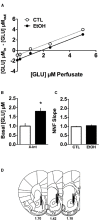Repeated cycles of chronic intermittent ethanol exposure increases basal glutamate in the nucleus accumbens of mice without affecting glutamate transport
- PMID: 25755641
- PMCID: PMC4337330
- DOI: 10.3389/fphar.2015.00027
Repeated cycles of chronic intermittent ethanol exposure increases basal glutamate in the nucleus accumbens of mice without affecting glutamate transport
Abstract
Repeated cycles of chronic intermittent ethanol (CIE) exposure increase voluntary consumption of ethanol in mice. Previous work has shown that extracellular glutamate in the nucleus accumbens (NAc) is significantly elevated in ethanol-dependent mice and that pharmacologically manipulating glutamate concentrations in the NAc will alter ethanol drinking, indicating that glutamate homeostasis plays a crucial role in ethanol drinking in this model. The present studies were designed to measure extracellular glutamate at a time point in which mice would ordinarily be allowed voluntary access to ethanol in the CIE model and, additionally, to measure glutamate transport capacity in the NAc at the same time point. Extracellular glutamate was measured using quantitative microdialysis procedures. Glutamate transport capacity was measured under Na(+)-dependent and Na(+)-independent conditions to determine whether the function of excitatory amino acid transporters (also known as system XAG) or of system Xc (-) (glial cysteine-glutamate exchanger) was influenced by CIE exposure. The results of the quantitative microdialysis experiment confirm increased extracellular glutamate (approximately twofold) in the NAc of CIE exposed mice (i.e., ethanol-dependent) compared to non-dependent mice in the NAc, consistent with earlier work. However, the increase in extracellular glutamate was not due to altered transporter function in the NAc of ethanol-dependent mice, because neither Na(+)-dependent nor Na(+)-independent glutamate transport was significantly altered by CIE exposure. These findings point to the possibility that hyperexcitability of cortical-striatal pathways underlies the increases in extracellular glutamate found in the ethanol-dependent mice.
Keywords: alcohol; microdialysis; mouse; transport; uptake.
Figures


References
-
- Bauer J., Pedersen A., Scherbaum N., Bening J., Patschke J., Kugel H., et al. (2013). Craving in alcohol-dependent patients after detoxification is related to glutamatergic dysfunction in the nucleus accumbens and the anterior cingulate cortex. Neuropsychopharmacology 38, 1401–1408. 10.1038/npp.2013.45 - DOI - PMC - PubMed
Grants and funding
LinkOut - more resources
Full Text Sources
Other Literature Sources

